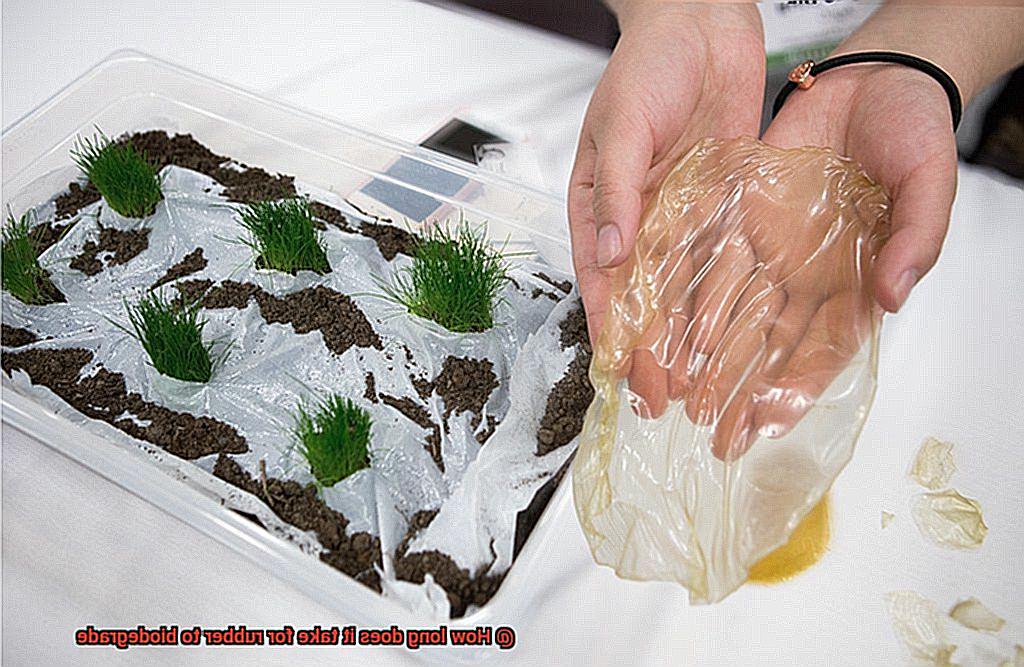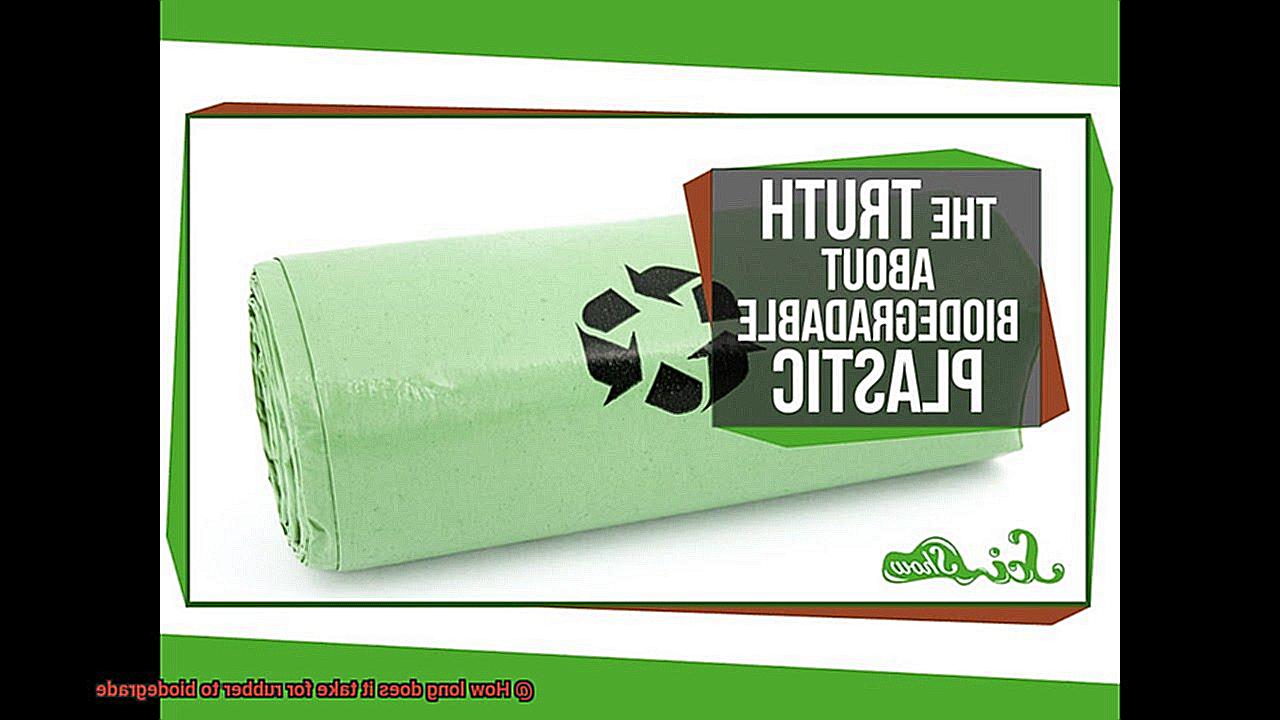Have you ever stopped to consider the impact of the products you use on the environment? Rubber is a ubiquitous material in our modern world, found in everything from tires to toys. But have you ever wondered how long it takes for rubber to biodegrade?
It’s not a simple answer. Natural rubber can break down relatively quickly, taking anywhere from a few months to a few years depending on the conditions. However, most rubber products today are made from synthetic rubber, which can take over 50 years or even up to 1,000 years to decompose.
This means that most of the rubber products we use will stick around for generations, contributing to landfills and pollution. But why does synthetic rubber take so long to biodegrade? And what can we do about it?
In this blog post, we’ll delve into the science behind rubber biodegradation and explore the challenges we face in reducing our dependence on synthetic rubber. We’ll also examine some of the emerging technologies and innovations that could lead us towards a more sustainable future.
What is Rubber?
Contents
Rubber is a fascinating substance with a rich history and a wide range of uses. It all starts with the sap of the rubber tree, Hevea brasiliensis. The sap is collected by making small incisions in the bark of the tree, and then treated with acids to produce rubber.
This natural material is highly elastic, making it perfect for use in many industries such as automotive, construction, and healthcare. Rubber is used to make tires, hoses, belts, seals, gloves, and countless other products that require flexibility, durability, and resistance to water and abrasion.
While natural rubber is biodegradable and can decompose over time through natural processes, it’s important to note that most rubber products are made from synthetic rubber. Synthetic rubber is petroleum-based and much less likely to biodegrade. This means that improperly disposed of rubber products can take hundreds of years to decompose, causing significant environmental pollution.
Research shows that synthetic rubber products like tires and shoe soles can take decades or even centuries to decompose in landfills. In marine environments, rubber can persist for even longer periods due to the lack of oxygen and high salt content. This poses a significant threat to marine wildlife.
Fortunately, there are ways to recycle and repurpose rubber products. Used tires can be shredded and used as fuel or in road construction materials. Rubber mulch made from recycled tires is perfect for landscaping and playgrounds. Some companies are also developing technologies to break down synthetic rubber into its constituent parts for reuse or disposal.
Natural Rubber vs Synthetic Rubber
Rubber is a versatile material that is used in countless everyday products, including balloons, gloves, and tires. However, the environmental impact of rubber products can be significant since it can take centuries to decompose in landfills or marine environments. This is where the difference between natural rubber and synthetic rubber comes into play, especially when it comes to biodegradability.
Natural rubber is derived from the sap of the Hevea brasiliensis tree and is biodegradable. Depending on environmental conditions, it can take anywhere from a few months to a few years to biodegrade. In contrast, synthetic rubber is made from petroleum-based products and is not biodegradable. Synthetic rubber can take hundreds of years to break down and can release harmful chemicals into the environment as it does so.
One of the reasons natural rubber is more environmentally friendly than synthetic rubber is that it is renewable. The Hevea brasiliensis tree can be tapped for its sap multiple times throughout its lifetime, and new trees can be planted to replace those that have been harvested. In contrast, synthetic rubber relies on non-renewable resources like oil and gas.
Furthermore, natural rubber is biocompatible, meaning it can be broken down by microorganisms in the soil. This makes it a valuable resource for composting and soil enrichment. On the other hand, synthetic rubber does not provide any such benefits since it cannot be decomposed by microorganisms.
How Long Does it Take for Natural Rubber to Biodegrade?
You’ll be pleased to know that natural rubber is an eco-friendly material that can break down over time. However, the exact duration of this process is influenced by several factors.
Firstly, the biodegradation of natural rubber occurs through the actions of microorganisms such as bacteria and fungi, which consume the rubber and convert it into simpler compounds. Studies show that this process can take anywhere from several months to several years depending on the environmental conditions.
In tropical climates with high temperatures and humidity levels, natural rubber can degrade relatively quickly due to the presence of more microorganisms that thrive in these conditions. Conversely, in colder and drier environments, the biodegradation process can take much longer.
It’s important to note that not all types of natural rubber biodegrade at the same rate. Vulcanized rubber, which is a type of natural rubber treated chemically to increase its strength and durability, is much more resistant to biodegradation than untreated natural rubber. The vulcanization process creates cross-links between rubber molecules that make it difficult for microorganisms to break down.
Additionally, the size and shape of the rubber item can affect its biodegradability. Smaller pieces of rubber tend to degrade more quickly than larger ones because they have more surface area for microorganisms to attack. Similarly, loosely packed rubber items will break down faster than tightly bound ones because they allow more oxygen and moisture to reach the microorganisms.
How Long Does it Take for Synthetic Rubber to Biodegrade?
Synthetic rubber is a durable and versatile material that is used in various industries such as automotive and construction. Unfortunately, it takes hundreds of years to decompose due to its strong chemical bonds.
Unlike natural rubber derived from rubber trees, which can biodegrade within a few years, synthetic rubber takes much longer. The chemical bonds that make up synthetic rubber are very strong and resistant to natural processes that break down organic materials. This means that when synthetic rubber ends up in landfills or oceans, it takes up valuable space for many years and poses a threat to wildlife.
Moreover, when synthetic rubber is exposed to sunlight and other environmental factors, it breaks down into smaller particles known as microplastics. These microplastics can be ingested by marine animals, causing harmful effects on their health.

To combat this issue, researchers are experimenting with various methods to make synthetic rubber more biodegradable. By using plant-based oils and proteins instead of petroleum-based ingredients during the manufacturing process, some researchers are making strides in creating biodegradable synthetic rubber. Others are exploring ways to incorporate enzymes or biological agents that can help break down synthetic rubber more quickly.
While finding ways to make synthetic rubber more biodegradable is still an ongoing process, it is crucial for us to reduce our impact on the environment. As consumers, we can also do our part by choosing eco-friendly products made from natural materials whenever possible and properly disposing of synthetic rubber items.
Environmental Impact of Non-Biodegradable Rubber Products
Rubber is a strong and durable material that has been used in countless products for decades. However, the environmental impact of non-biodegradable rubber products is a growing concern for many people. When these products are not disposed of properly, they contribute significantly to landfills and waste disposal sites, taking up valuable space and posing a risk to wildlife.
But the harmful effects don’t end there. Rubber products that end up in waterways can release toxic chemicals and pollutants that contaminate the water and harm aquatic life. Additionally, rubber items can leach harmful toxins into the soil, which can have negative impacts on plants and other living organisms.
The production of rubber also has environmental consequences. The extraction and processing of natural resources like latex sap or petroleum-based synthetic materials used to make rubber can result in pollution, deforestation, and other forms of environmental damage.
As consumers, we have a responsibility to be mindful of the long-term impact of non-biodegradable rubber products on the environment. We can choose eco-friendly alternatives made from natural materials whenever possible and dispose of synthetic rubber items properly.
The scientific community is also working to find more sustainable solutions to this issue. One promising avenue is using plant-based oils and proteins instead of petroleum-based ingredients during the manufacturing process or incorporating enzymes that can break down synthetic rubber faster.
Ways to Recycle and Repurpose Used Rubber Products
There are ways to recycle and repurpose used rubber products. In this blog post, we’ll explore seven fascinating subtopics that explain these different methods.
Shredding
The most common method of recycling rubber is shredding. This process involves shredding used rubber products like tires, shoes, and hoses into smaller pieces that can be used for various purposes. Shredded rubber is versatile and can be used as filler material in playgrounds, insulation in buildings, or even as a component in asphalt. By shredding old rubber products, we can reduce waste and conserve resources.

Reusing
Instead of discarding old rubber products, some can be reused. For example, old tires can be repurposed as planters or swings in playgrounds. Rubber mats can also be transformed into flooring material in gyms and other commercial buildings. Reusing old rubber products is an effective way to reduce waste and save money.
Repurposing
Another excellent way to give new life to used rubber products is through repurposing. Old tires can be turned into furniture such as chairs and tables. Rubber hoses can also be transformed into garden decorations or outdoor lighting fixtures. By repurposing old rubber products, we can reduce waste and create new items without using new resources.
Recycling
Recycling used rubber products into new ones is an effective way to conserve resources. Recycled rubber can be used to make new tires, gaskets, and seals. By recycling old rubber products, we reduce waste and conserve natural resources.
Pyrolysis
Pyrolysis is a process that involves heating rubber to high temperatures in the absence of oxygen. This process breaks down the rubber into its constituent chemicals, which can then be used to make new products. Pyrolysis is an innovative way to recycle rubber and reduce waste.
Crumb Rubber
Another way to recycle rubber is by creating crumb rubber. This material is made by grinding up old tires into small pieces. Crumb rubber is commonly used as a component in artificial turf fields or in playground surfaces. By creating crumb rubber, we can reduce waste and create new materials.
Energy Recovery
Some rubber products are burned for energy recovery purposes. This process generates electricity and heat that can be used to power homes and businesses. By burning rubber for energy recovery, we can reduce waste and create new sources of energy.
VuzPkkM3bjQ” >
Conclusion
In summary, rubber is a ubiquitous material in our modern world that poses a growing concern for the environment. Synthetic rubber products can take up to 1,000 years to decompose, while natural rubber can break down relatively quickly depending on the conditions.
The biodegradability of rubber depends on whether it is synthetic or natural. Natural rubber is renewable and biocompatible, making it an eco-friendly material that can be broken down by microorganisms in the soil. In contrast, synthetic rubber relies on non-renewable resources like oil and gas and cannot be decomposed by microorganisms.
The impact of non-biodegradable rubber products on the environment is significant. They take up valuable space in landfills and waste disposal sites, posing a risk to wildlife. However, there are ways to recycle and repurpose used rubber products such as shredding, reusing, repurposing, recycling, pyrolysis, crumb rubber creation, and energy recovery.
As responsible consumers, we have a duty to consider the long-term effects of non-biodegradable rubber products on the environment. We can opt for eco-friendly alternatives made from natural materials whenever possible and dispose of synthetic rubber items properly. The scientific community is also actively seeking sustainable solutions for this issue through innovative methods such as using plant-based oils and proteins instead of petroleum-based ingredients during manufacturing processes or incorporating enzymes that can break down synthetic rubber faster.
In conclusion, let us make conscious choices towards reducing our impact on the environment by opting for sustainable solutions when it comes to using and disposing of rubber products.





